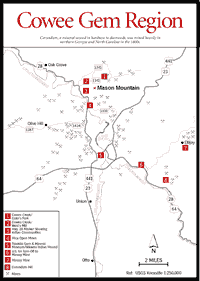 The
Cowee Gem Region
The
Cowee Gem Region  The
Cowee Gem Region
The
Cowee Gem Region During the late 1800s, corundum—a mineral second in hardness only to diamond—was mined extensively in north Georgia and North Carolina. Corundum was valuable in the manufacture of abrasives such as sandpaper. Impurities in the mineral also resulted in gem-quality sapphires and rubies, which were sometimes found during the course of mining corundum ore. In fact, the mineralized zone running northeast and southwest through Georgia and North Carolina was second only to the Mogok region of Burma as a source of high-quality rubies and sapphires. After the discovery that, with plentiful electricity, aluminum oxide could be artificially fused to make corundum, the commercial mining operations quickly closed down, and the economics of gemstone mining never made it a viable industry in the area. Presently, Thailand seems to be the main source of gem-quality rubies and sapphires. In more recent years, serious rock hounds and those just simply curious have discovered that the Cowee gem region and a number of locations around Franklin, North Carolina, still produce valuable gems, primarily for the tourist market. Most mines in Macon County are placer or gravel deposits. The gems weather out of decomposing bedrock higher in the watershed and are washed down by streams. Most of the gem mines furnish equipment, shovels, screens, and running water to wash the gravel. Either there is a flat fee, or one pays for the processed gravel.
[Fig. 52(5)] Located in the 15-year-old brick jail, the museum displays a variety of Macon County minerals, including a 48-pound corundum crystal. This is a good first stop on a visit to the area to become familiar with the appearance of the minerals and gems mined nearby.
A number of these mines lie along Caler's Fork [Fig. 52(1)] on Cowee Creek [Fig. 52(2)]. Many of these mines, as well as others in the area, have native gems such as rubies, sapphires, and garnets. Some also sell "enriched" gravel by the bucket, meaning that exotic (and inexpensive) stones from all over the world have been added to the raw material.
[Fig. 52(8)] This famous corundum mine has yielded some fine gems, including sapphires in orchid, green, yellow, pink, and blue, as well as 587- and 760-carat rubies. This deposit is associated with the ultrabasic rocks serpentine and dunite, as is the corundum at the Buck Creek olivine pine barrens.
[Fig. 52(7)] This is another well-known deposit of unusual bronze sapphires which "star." No equipment is furnished here.
Directions: Go 2.4 miles east of the US 44/164 interchange on US 64, turning left [Fig. 52(6)] just before the first bridge and proceeding 5.8 miles to Ellijay, North Carolina. Inquire there.
The Franklin area is also noted for the occurrence of a splendid rose-pink variety of pyrope garnet called "rhodolite," first discovered on Mason Mountain. One can visit the Mason Mountain Rhodolite Mine or screen or pan for garnets in the gravels of Mason's Branch, Cowee Creek, and Caler's Fork. With luck, amateur miners might recover a piece of ruby or sapphire corundum. Mason Mountain is just south of Caler's Fork. Watch for signs.
A look at the map [Fig. 52] will indicate the stunning number of old or active mines in the area around Franklin (mine symbols). All are not gem mines. Some are giant, open cuts where mica or other minerals were mined [Fig. 52(4)]. This particular mine has enormous amounts of almost pure-white quartz. Unfortunately there are no good maps to the location of Macon County mines, nor is there information as to what is or was mined at particular sites. A few mines are no longer on revised 7.5-minute topographical maps. Inquiring of local residents seems to be one of the most productive means of finding interesting localities.
[Fig. 52(5)] The Franklin area is rich in Indian history and prehistory. Practically in the center of Franklin is an Indian mound on the south bank of the Little Tennessee River at the bridge. Near West's Mill there is a marker on NC 28 showing the location of the major Indian communities of Cowee [Fig. 52(3)] on the floodplain of the Little Tennessee River. Explorer and naturalist William Bartram passed through the Franklin area in the late 1700s.
Read and add comments about this page